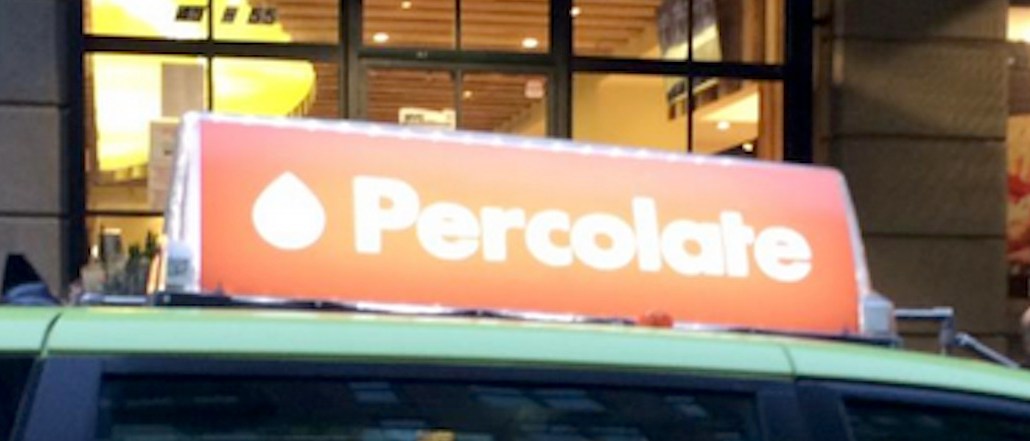Connect with execs from The New York Times, TIME, Dotdash Meredith and many more

There’s an irony that a company dedicated to helping brands improve their online marketing opts to market itself through outdoor ads.
But for marketing tech startup Percolate, a heavy presence in outdoor, mostly on top of cabs, allows it to stand out. James Gross, co-founder, said that he has a very specific target in mind when he thinks about investing in outdoor. It’s not for people to ask, “What’s Percolate?” and then go Google it, he said. Instead, it’s for marketers who already know what the company does; the ad is the nudge that may encourage them to get back in touch, or give the company a call. But Gross said, of course, the first one — just getting people to become aware of the company — does happen.
“We don’t have a lot of evidence of it working,” he said, “but we do look at some click paths and see where the queries are coming from and so on.”
There’s also the intangible: Outdoor has a higher barrier to entry — “you can buy an online ad for 14 cents,” said Gross — and so it makes people think of the company differently. Gross also said there is an employee investment angle. Percolate now employs about 240 people, he said. “Our ad also touches a tertiary audience, the people we want to hire and the people who work here,” he said.
Of course, it’s not just marketing tech startups that are making a splash outdoor. Consumer companies like mattress company Casper is a presence in the subway — co-founder Luke Sherwin says it was the best place to get a captive audience — as does Seamless and health insurance company Oscar.
Still, those services are trying to reach millions of consumers. For business-to-business startups, the equation would ostensibly be different. Then again, the crowded marketing in advertising and marketing technology, not to mention the billions invested in companies in those sectors, make a dash for mindshare make more sense. After all, Buddy Media raised eyebrows with its aggressive outdoor marketing, focused mostly in airports, but then was bought by Salesforce for nearly $700 million.
“We’ve seen a real upswing in the past three years,” said Carly Zipp, spokeswoman at Outfront Media (formerly CBS Outdoor), one of the largest OOH inventory owners in the country, who added that the interest runs the gamut from smaller tech and martech companies to giants like YouTube.
Shai Goldman, managing director of SVB Capital, who also runs a Tumblr documenting startup ads on outdoor media, said that one other reason why startups are bullish on outdoor is because they’re finding that Facebook and other social advertising is getting more expensive and possible less effective. “People just want to try new channels,” he said. Outdoor also might make you think the company “supposedly has money” to either attract customers or maybe even new hires.
Matt Sraz, founder and CEO of HR software company Namely, which also runs outdoor ads in New York, said he’s a fan because it can be targeted to specific neighborhoods. There’s also the opportunity to get into a space traditionally dominated by legacy competitors. “And perhaps the best reason: It works,” he said. “We can track website traffic increases to our OOH advertising in specific geographies.”
Buddy Media was probably the company that started it all. Five years ago, when the company was just starting to define its business, decided it needed to capture CMO and digital marketer attention, and bought out-of-home space in airports and across cities. “In a new market, there is the leading brand and then everyone else,” said Mike Lazerow, founder and CEO of Buddy media. It was pretty unheard-of for a startup at that stage to go all out in airports and outdoor, but Lazerow and his team thought it was enough. “No other vendors were doing integrated campaigns across out-of-home and digital,” said Lazerow. “We stood out.” The result, the company said, speaks for itself: “We were acquired by Salesforce for $689 million.”
Definitely didn’t expect airport advertising from @BuddyMedia cc: @lazerow pic.twitter.com/gXSlI1yM — Omid Ashtari (@omid) December 10, 2011
“The genius of New York is that it’s like, a six-by-three island, so lots of people that we need to see the ad see the ad,” said Gross. While it may be a bit weird to run cab ads anywhere else, it makes sense since a lot of marketing people and agency-side people live, work and commute through New York. One of the biggest challenges about being a growing brand is “getting your product back in front of senior folks that make buying decisions,” he said. New York is the place to do it.
But at the same time, he’s clear about outdoor’s limitations: “People ask if we have thought about putting more messaging on it, and that’s definitely a no. How would anybody have time to read it?”
Homepage image via @bmorrissey
More in Marketing

WTF is ‘Google Zero’?
The era of “Google Zero” — industry shorthand for a world where Google keeps users inside its own walls — is here.

The next browser wars are here — and AI wants the ad dollars too
Perplexity and OpenAI are getting ready to take on Google’s Chrome, but will need a solid ad business to keep their browsers ticking along.

Vista Equity Partners’ TripleLift implements ‘significant’ layoffs
The latest round of layoffs is understood to have impacted all departments at the SSP across multiple geographies.





